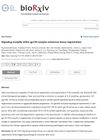Search
forLearn
3 / 3 resultslearn Osteopontin
signaling protein that, when suppressed, may grow hair by reducing inflammation and stem cell loss
learn Redensyl
commercial product with a blend of mostly natural ingredients for hair regrowth
Research
5 / 1000+ results
research Signaling Modality Within GP130 Receptor Enhances Tissue Regeneration
The gp130 receptor helps in tissue regeneration and disease progression, and manipulating it could improve healing and prevent disease.

research The Influence of Interferon on Healthy and Diseased Skin
Type I interferons play a key role in the development of various skin diseases.

research Alleviation of Androgenetic Alopecia with Aqueous Paeonia Lactiflora and Poria Cocos Extract Intake Through Suppressing the Steroid Hormone and Inflammatory Pathway
Paeonia lactiflora and Poria cocos extracts can potentially increase hair growth and reduce hair loss symptoms by lowering testosterone and inflammation levels.

research Pu-Erh Tea Reduces the Transmission of CRD-Mediated Alopecia Risk to Offspring
Pu-erh tea reduces hair loss risk in offspring.

research Index
Community Join
5 / 114 resultscommunity What is the real impact of dutasteride on neurosteroids? A little review of 2 scientific datas
Dutasteride at 0.5 mg/day does not significantly alter allopregnanolone levels, but higher doses (2.5 mg/day) do. Dutasteride may also have anti-neuroinflammatory effects, but the impact on neurosteroids is still debated.
community HLT Megathread on HMI-115 (key takeaways in comments)
HMI-115, a newly discovered hair loss treatment that could potentially be effective for those with diffuse thinning and telogen effluvium. It is based on prolactin receptor antagonist signaling and has already undergone Phase I trials in women, with potential commercialization by 2027.
community Finasteride does deplete important nuero-active steroids
Finasteride can reduce neuroactive steroids, causing side effects like depression, anxiety, and sexual dysfunction. Some users experience persistent symptoms after stopping finasteride, while others use alternative treatments like topical solutions.

community Compressed part of research of theory of androgenic/anabolitic balance. AGA h-responders analytic. Theory of physio-metabolitic method of anti AGA treatment
The treatment for androgenetic alopecia involves using finasteride and minoxidil with intense exercise and cold exposure to boost metabolism and reduce androgenic effects, potentially leading to hair regrowth. This approach may activate biological pathways for improved hair and overall health.
community Why hasn’t anyone made a "DHT sponge" biologic yet???
The conversation discusses the potential for developing a biologic "DHT sponge" to neutralize DHT in the bloodstream as a treatment for hair loss, suggesting it could be more targeted and have fewer side effects than current treatments like finasteride and dutasteride. Concerns include the complexity, cost, and potential side effects of such a treatment, as well as skepticism about its feasibility and market interest.